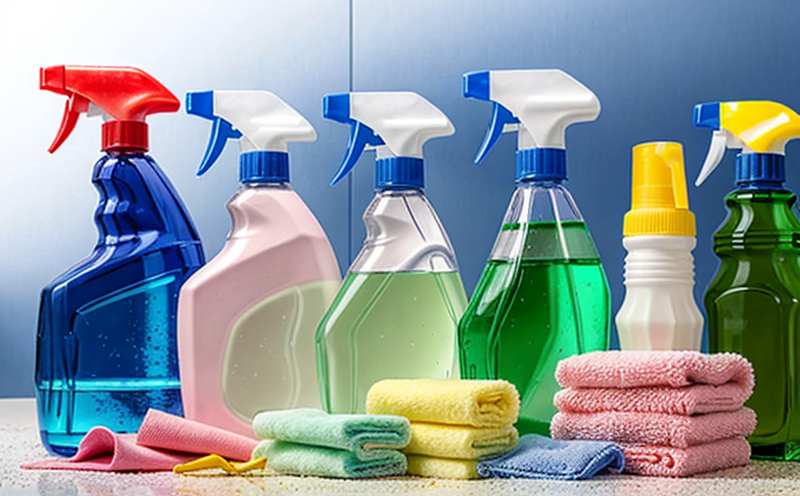Surface Tension Testing of Cleaning Products
The surface tension testing of cleaning products is a critical process that ensures the product's effectiveness in various applications. Surface tension plays a pivotal role in the performance of cleaning agents, influencing their ability to lift and remove dirt, grease, and other contaminants from surfaces. This test evaluates how effectively a cleaning agent can wet a surface, which directly impacts its overall efficacy.
The technique involves measuring the force required to stretch or break the surface of a liquid. For cleaning products, this means assessing how much resistance the product exerts against forming a thin film on a surface. The lower the surface tension value, the better the cleaning agent's ability to spread across and penetrate into surfaces. This property is essential for achieving thorough cleaning and ensuring that no residues remain after use.
Surface tension testing is particularly important in consumer products where user experience and product performance are paramount. It helps manufacturers optimize their formulations to meet both regulatory requirements and customer expectations. By understanding the surface tension properties, developers can tailor their formulas to enhance wetting ability, improve emulsification, and reduce the risk of residue buildup.
Industry standards such as ASTM D5789 and ISO 3216 provide guidelines for performing this test accurately. These standards outline specific procedures for sample preparation, measurement techniques, and acceptable ranges for different types of cleaning products. Adherence to these protocols ensures consistency and reliability across various testing environments.
When selecting a laboratory for surface tension testing, it is crucial to consider factors such as expertise, equipment capabilities, and compliance with relevant standards. A reputable testing facility should offer comprehensive services that cover all aspects of the test process, from sample preparation through final analysis and reporting. This ensures not only accurate results but also timely delivery of reports that can inform product development decisions.
In conclusion, surface tension testing is an indispensable tool for ensuring high-quality cleaning products. By leveraging this technology, manufacturers can improve their products' performance while meeting stringent regulatory demands. Whether you're a quality manager looking to enhance your product offerings or an R&D engineer seeking to innovate new formulations, understanding the significance of surface tension in cleaning products will undoubtedly prove beneficial.
Benefits
The benefits of conducting surface tension testing on cleaning products extend beyond mere compliance with regulations; they provide valuable insights into product performance and user satisfaction. By measuring the surface tension, manufacturers can optimize their formulas to enhance wetting ability, improve emulsification properties, and minimize residue formation.
One significant benefit is improved performance in heavy-duty cleaning applications where high-efficiency is crucial. Understanding how different ingredients affect the surface tension helps in creating more effective solutions for challenging dirt removal tasks. This optimization leads to products that are not only potent but also safer for use around children, pets, and sensitive areas like kitchens.
Another advantage lies in cost savings associated with improved product longevity. Cleaner surfaces require less frequent reapplication of the cleaning agent, reducing operational costs over time. Additionally, reduced residue formation translates into lower maintenance requirements for both consumers and commercial facilities using these products.
Safety is also a key consideration. Lower surface tension values indicate stronger wetting capabilities, which can help prevent skin irritation or other adverse effects when used as directed. Furthermore, understanding the interaction between different components during formulation allows chemists to develop safer alternatives where necessary.
Lastly, compliance with international standards ensures that your products meet global market demands without compromising quality. Whether you're targeting specific regions like Europe (EN 50472) or North America (ASTM D5789), adhering to these guidelines demonstrates commitment to excellence and trustworthiness among customers.
Industry Applications
| Application | Description |
|---|---|
| Bathroom Cleaning Products | Evaluating the effectiveness of bathroom cleaners in removing soap scum, lime deposits, and other residues from fixtures. |
| Cookware Degreasing Agents | Assessing the ability to break down grease and oil films on cookware surfaces for easy cleaning post-use. |
| Determining how well laundry detergents penetrate fabrics to remove stains without leaving any visible residue after washing cycles. |
| Application | Description |
|---|---|
| Car Care Products | Evaluating the performance of car care products in removing dirt and grime from vehicle exteriors while ensuring they do not damage paintwork or finishes. |
| Hard Surface Cleaners | Making sure that hard surface cleaners effectively clean floors, countertops, tiles, and other non-porous surfaces without causing streaking or leaving behind any residues. |
| - | - |
Environmental and Sustainability Contributions
Incorporating surface tension testing into the development process of cleaning products contributes significantly to environmental sustainability efforts. By optimizing formulas for lower surface tension, manufacturers can reduce water consumption during production processes by creating more efficient solutions that require less rinse water.
The reduction in residue formation also implies a decrease in waste generation since fewer chemicals end up as contaminants in wastewater systems. This aligns with broader goals of minimizing environmental impact and promoting sustainable practices throughout the supply chain.
Moreover, the improved performance of these products encourages responsible usage by consumers who are aware that their choices contribute positively towards protecting natural resources. As awareness grows about eco-friendly practices, businesses that prioritize sustainability will benefit from enhanced brand loyalty and reputation among environmentally conscious customers.
Surface tension testing plays a crucial role in achieving these objectives by providing actionable data for continuous improvement within manufacturing processes. It enables companies to make informed decisions regarding ingredient selection, process optimization, and ultimately contribute towards creating cleaner environments both locally and globally.





